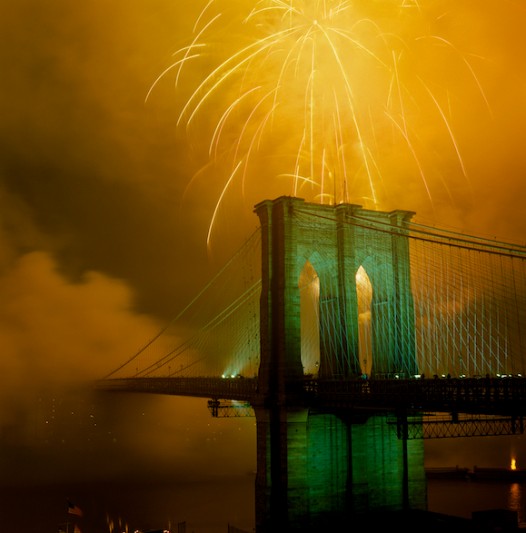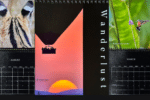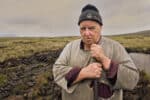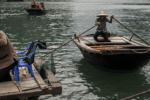Summer’s here! Time to shoot some fireworks. Below is a small instructional essay from the Life Guide to Digital Photography. I’ve shot some of the biggest fireworks displays in history, so I just kind of dove back into those to remember things I did right and things I did wrong. And things I didn’t think of at the time, or should’ve remembered to do. If you read this, or get the book, you might have an easier time than I did, being out there thinking, “Geez, I wish I had remembered to bring….”
Everybody loves to shoot fireworks. It has lots of connotations—holiday, patriotism, hot dogs, weekend, kids, family. Time to relax. Time to shoot some pictures.
Okay, make a checklist. Camera. Wide angle zoom. Telephoto zoom. Flash cards. Cable release. Spare camera battery. Tripod. Headlamp, and hand held flashlight. Watch with timer function. Black card. (More on that later.)
That’s pretty much the photo kit. What else to think of? Rain gear, both for cameras and you. You can get fancy rain gear designed for cameras and lenses, or just use plastic bags and baggies. Couple of bungee cords to keep the bags on the camera if the wind starts whipping about. Water and power bars—you’ll be out there a while. Bug repellent. Comfortable clothing and shoes. The car might be quite a ways away, and you’ll be walking a fair piece. Advil. (Advil is always on my equipment list.)
Anything to do beforehand? You bet. Scout the location. Best to know what you are getting into, where they shoot the fireworks from, what the background will be like. How big will the display be? How long will it go for? Most fireworks displays are well over in a half hour or less, and if you are stumbling around in the crowd looking for a spot and trying to setup in the dark, you’ll just be starting to make decent exposures as they light up the sky with the crescendo and say goodnight till next year.
That’s right, next year. Most big shoot ’em ups are yearly events. Argh, the pressure!
So scout. Get your spot. Get there early. I mean early. Like, be the first car in the parking lot. Pack a soft cooler sling bag, throw an icepack in there, and know that in that bag is your sustenance till maybe late at night. For jobs like this, my Ipod and earphones are a must. Maybe a collapsible chair, and a small waterproof tarp. Think your way into this. What could go wrong? It’s a photo shoot, so the answer to that is, just about everything. Try to ensure success by envisioning the shot and the potential problems in making the shot before you walk out the door.
Like, do you need a permit to put your tripod down? Did you have to call the town about this adventure? Most likely not, but in this post 911 world, photographers are often treated as being just this side of a recidivist offender, so it might be worth a phone call.
Okay, prepped and ready. Time to frame up the shot, which is a bit trickier than you might think. First off, when I shoot fireworks, I always get my frame, plus about 20%. I can always tighten up, but I want to give those fireworks room to play up there in the heavens. Frame too tight, you’ll have tracer lines of color going right out of the upper part of your picture, creating lines of interest that will pull your viewer’s eye right out with them.
So give them room to breathe and determine whether the shot is horizontal or vertical. Remember that most fireworks pix, if they are just of the explosions in the sky, are, at the end of the day, an exercise in color, nothing more. Even something as splashy as a pyrotechnic display needs context. So perhaps you can frame up with the object that is being celebrated, such as the Statue of Liberty. Or use the semi-silhouetted crowd as a foreground element. Or boats and bridges out in the water, with the water acting as a giant reflector board filled with color.
The variations that may occur with your framing are the reason to have at least a couple lenses with you. As mentioned above, two reasonable zooms, one wide and one telephoto, should do you fine.
Metering? Yikes, how do you meter a fast moving rocket moving through the black sky? The answer is, you don’t, really. This is a situation to shut off a bunch of the auto this and that on the camera, and go manual. Also, make sure to turn the flash off. Some cameras will read the darkness in in certain modes and activate that puppy. Ever see the opening of an Olympics, where thousands of people are using point and shoots, and their flashes are going off like crazy? Know what they’re lighting? The shoulder of the person in front of them. Fireworks, unless you are trying a radically different approach, are generally a no flash zone.
Okay, now set up manual. Fireworks are brighter than you might think, so you don’t need to open the lens really wide, which is a bit counter-intuitive, I know, ’cause it’s dark. But my experience with fireworks wide open is that you drain the color out of them. They’ll just register as a white streak. Be careful. You can over-expose fireworks quite easily.
F8 is a reasonable starting point. Some photogs I know go even lower on the aperture scale, down to f11 or even f16. Over time, you will find which settings work for you. (I used to take notes at the end of a fireworks job, just to keep myself tuned up for next year. No real need for that anymore, as the metadata tells you what works and what doesn’t.)
Set the shutter to bulb. This mode keeps the shutter open as long as the release button is pushed. But you are not physically pushing that button are you?! No! This is absolutely a job for a cable release. Nowadays, most cable releases are simply electric cables which jack into the camera and activate the shutter. When you punch the button on the cable release the shutter is at your command, and will stay open as long as you want. And, very significantly, the button you are pushing is not on the camera or the tripod. With lengthy exposures, even the slightest jiggle or vibration is the enemy.
This is important, because at f8, the shutter will be open for a while, meaning anywhere from four to 10-15 seconds. (Remember if you have a foreground element in the picture, such as a monument, you have to make sure that lit up monument is exposed properly. In many ways, that foreground object will determine the length of your exposure.)
Again, due to the brightness of fireworks, you can work at a reasonable or even low ISO. Something in the neighborhood of 100 or 200 will do fine. The faster your ISO, the shorter your shutter speeds, which will deprive you of recording those wonderful tracers of light into the sky.
Some shooters time the launch of the rockets and open their shutter accordingly, keeping it open for, say, 8-10 seconds, then closing down. This ensures that they will record the path of the pyrotechnic into the night sky, and it’s explosion. This is a fine approach. Give it a try.
Others use a black card. A black card is just that, a black card. Nothing mysterious or fancy. It can be a piece of black cardboard, or foam core board. Or it can just be an index card covered with black tape. (Be sure it is not shiny tape. That might pick up slivers of light and reflect it back into the lens. Use a matte black type of photo tape, often called gaffer tape.)
This way, you can keep your shutter open for very lengthy periods of time, and record multiple starbursts. You open the shutter, and shoot one explosion, then cover the lens with the card, and wait for the next. You can experiment with this trick, and produce really terrific results by layering multiple fireworks into one picture.
(Also, say, you have the Brooklyn Bridge as an architectural element in the foreground, and the proper exposure for it is f8 at 10 seconds. This limits your fireworks shooting range, right? Gotta get the bridge right, so the exposure is a done deal. But, with the black card, if you are quick enough, you can uncover just the upper portion of the sky, while blocking the area of the lens which is recording the bridge. This is dicey. You have to move the card quickly, hovering it around where the bridge ends and the sky begins. If you have ever made a black and white print in the darkroom, think of this as burning and dodging right at the camera lens. Can’t keep the card static or it will create a hard line of obvious exposure change. It has to hover, quickly jiggling around that sky bridge borderline. If you pull this off right, you can keep your lens open for several batches of fireworks, extending over 20-30 seconds, filling the sky with color. But—this is an experiment! Back yourself up by shooting some “straight” frames.)
At the beginnings of the digital rage, this technique was a bit problematic, because seriously lengthy exposures produced a lot of digital noise. The longer the shutter is open, the longer the chip is “on” building up heat with every passing second. That sensor heat would really fray away at the quality of the digital file you would be trying to produce. Bad news. Long time exposures were the Achilles heel of early digital cameras. Predictably, advances in digital camera technology have smoothed out a lot of those problems, but it is wise to experiment with your particular model and see what its’ tolerances are. As you might suspect, the higher end models handle long exposure well, while the more basic cameras will have limitations. Get to know what your camera is capable of. In many current cameras, you can turn on a function called “long exposure noise reduction.” Hugely helpful.
Other bits and pieces: Don’t shoot all night long at one exposure. (If you are on bulb, you definitely won’t anyway.) But this is an occasion for bracketing, and shooting as many frames as possible. Also, shoot right away when they start! Fireworks displays can build up a lot of smoke over a series of explosions, and if you are smack in the wind pattern that blows that smoke towards your lens, you can end up thinking you’re shooting a war zone. So shoot immediately, and fast.
Have a good 4th of July. Try some of this out, and have a hot dog on me. More tk….
















Great post Joe! Lots of tips and tricks that will ensure our Canada Day pics (July 1) will hold up against 4th of July pics.
I don’t know if you’ve ever shot “The Freedom Festival” in Windsor/Detroit. Its a 1 week party involving both cities, fairs, events & fireworks. Huge fireworks. 3 barges spanning the main part of waterfront.
It’s a great time of year in that part of our countries. I used to look forward to seeing the fireworks every year. Maybe I’ll get a chance to get back there and document them sometime.
Thanks for the tips Joe.
Let’s talk soon!
Thank you for posting and the shots are gorgeous
I have shot quite a few fireworks displays. Here in Louisville, KY we have the annual Ky Derby Festival “Thunder Over Louisville” supposedly the largest dispay in America. I have found my best results are ISO200 – f8 -6 seconds. I get to do this each year and it still FUN.
Joe Great tips for shooting Fireworks!
I like the black card trick might use that one…
Have a happy 4th hope to see you in ATL soon
Mike
Great tips Joe – also stealing a march on the July 4th fireworks frenzy. Last few years I’ve given up on the tripod and just shot hand-held. I’ll make a post with some of my images and link back.
As a Brit living in Houston, I usually take my (New Orleans) wife and (Texas) kids to the U.K. over July 4th timeframe. I’ve lost count of the number of times I’ve been asked, “How do you celebrate July 4th in England?”. The inevitable response, “With several pints of warm beer.”
As usual, GREAT TIPS and reminders. Thank you.
Another great post Joe. I recently did a tips list on my own blog because a few I know with new DSLRs keep asking me about the Magic Settings. There are none as you know. You may blow things on the first try, but this is another one of those situations where you must “dance with the light” and feel the moment.
One of my own tips was a little different. Go to youtube and find a few simple fireworks videos. They don’t have to be professionally shot. Study the evolution of the burst from firing to explosion and count things off in your head as you watch. Things will then become almost intuitive with some practice. Part of successful shooting is halfway knowing what to expect.
Congrats on your blog award too – you’re the best 😉
I don’t even like shooting fireworks, but damn I enjoy reading your blog. You force me to learn more in this way, and the opportunity to practice some “dodge and burn” skills might just mean that when it is Diwali time in Durban (South Africa) I might just set up on the beach front and shoot some frames..
Thanks for an awesome blog
Chris
Beware that turning on the “Long Exposure Noise Reduction” feature can have some seriously negative effects when you have something time sensitive like fireworks.
In my Canon 40d, doing that gives me this issue where the processing takes as long as the exposure. By that I mean, if i take a 10 second photo, after the shutter closes it takes 10 seconds to process, a 30 seconds shot takes another 30 seconds to process afterwards (and so on). During that time my camera is locked down and I can’t do anything.
Best to turn that feature off in this scenario and learn to deal with noise reduction back in post when you have all the time in the world.
Thanks for the reminder – I forgot that part of the book. and for those that don’t have it its a great read.
Got the Book..Great Stuff.
Great post, Joe! Thanks for the tips. I shot fireworks for the first time a couple of years ago and was thrilled with the results. Tried it again last year and they sucked. I had my focus set to close-up, not infinity! What a dope…but they looked great on the LCD panel that night. Not so much when I got them back home on the computer. I’m going to retry this year, and use your suggestion to get something interesting in the foreground.
–John
‘Fireworks, unless you are trying a radically different approach, are generally a no flash zone.’
:-))))))))))))))
…and that’s why i like particularly your blog!
Just imagined the situation when i go so near to the fireworks to be able to flash it and burst out in laughter 😀
Joe,
Your book is great on the iPad! As a media teacher, is there a way to get a group license for class room teaching?
Cheers,
Bob Hewitt
Hong Kong International School
Thanks Joe, love it!
One question, focus. Nikkor lens seem to allow focus *past* infinity. Any tips for getting the focus set…yes, I know, trial and error…any others?
Love the blog.
“Some shooters time the launch of the rockets and open their shutter accordingly”
That may be appropriate for some cases, but the risk of overexposure is quite high with this strategy. I tend to go for a different timing: Open the shutter when the display is at the maximum size and close it, when they just launch the next salvo. With this strategy, you can get a decent firework display and use the whole pause to catch some light from your foreground motifs like the Brooklyn Bridge or the Statue of Liberty.
Additional bonus: Comparable to flashing on the second curtain, the firework display will not superimpose your main motif.
information on the fit is good enough to increase my knowledge further
Thanks Joe! I always enjoy getting out and shooting fireworks, some good results, some bad. I’m especially interested in trying the black card tip with multiple sets!
Dude, thanks for the reminder. Plus the fact that you a right about scouting out locations. All too often we (read I) wing it because we’ve been there before and/or we just trust our “talent” too much.
Joe, great tips! I might have missed it in your tips but manual focus would be another tip. Great shooting everyone!!
This is a truly great post. It’s a rare thing to come across someone who clearly knows how to photograph fireworks. The Statue of Liberty shot up top is just stunning!
I photographed this set of Lake Murray South Carolina 4th of July 2002 fireworks displays: http://www.flickr.com/photos/ralphhightower/sets/72157629083111744/
Equipment used: Canon A-1, 80-205mm, Kodak Ultra 400 GC film, tripod and a pontoon boat. I used a tripod, but since I was on a boat, there is some motion in the fireworks. I set the camera on a 30 second exposure and held my hand in front of the lens between bursts. When I thought I had enough bursts, I’d cancel the 30 second exposure.
What a wonderful post and gorgeous photo above. That time of year again already and I’m thinking of experimenting a bit so these tips shall come in handy. Came across a post worth sharing with the folks lacking a good piece of equipment but still would like some pointers to shoot with their mobile: http://www.real.com/resources/fireworks-video-shooting-tips Thanks again.
Shooting Fireworks Joe McNally& – decent page to bookmark
Thanks! Will defenatly try this out tonight at new yrs eve…